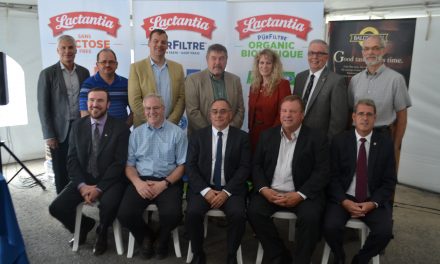A better option
Jordan Wallace cuts a swath during the strip-till demonstration for the Dundas Soil and Crop Improvement Association Seeding and Equipment Demonstration Day at the end of August. Van Dusen photo

Farmers examine the results of the strip tillage demonstrations. Van Dusen photo
by Tom Van Dusen
AgriNews Staff Writer
CHESTERVILLE – So far, only a handful of eastern Ontario farmers have moved over to strip-till systems… but there’s a lot of interest in the method as manifested during the successful Dundas Soil and Crop Improvement Association Seeding and Equipment Demonstration Day at the end of August.
Most farmers are still on the fence as they continue examining strip-till results at demonstration days such as the one organized by DSCIA, said association director Marty Derks who hosted the event.
With 150 farmers and other interested parties on hand, the demo day took place on 800 acres of Derks farmland along Highway 43 between Winchester and Chesterville. Donuts and barbecued sausages kept participants happy between bursts of action out on the field, with the latest in precision planting technology presented by several local equipment dealers.
Derks said he’s researching a switch to strip tillage, a cross combining the benefits of conventional with the advantages of no-till. It would be a costly proposition, Derks said, especially for the 16-24 row equipment that he’s considering and the extra tractor power needed to pull it. On the other hand, the new equipment – which also spreads fertilizer – would allow him to retire three other machines and get along with three fewer hired hands.
With strip till, tractors operate at a higher speed for maximum impact. After dealer Jordan Wallace ran his six-row Dawn Pluribus strip tiller (value $47,000) across a section of field, farmers were down on their knees, pushing earth divots aside to study the width and depth of the shallow trenches. More than once, they were asked to step back so Wallace could safely make a second pass.
Proponents believe that strip-till warms the soil, fosters an aerobic condition, and creates a better seedbed than no-till. In addition, they claim strip-till allows the soil’s nutrients to better adapt to the plants’ needs while still giving cover to soil between the rows. In terms of erosion, the amount on a strip-tilled field is light compared to deep conventionally tilled. With a strip-till system, liquid fertilizer can be directly applied in rows where seed is being planted, reducing quantity needed while getting closer to the roots.
Strip-till, its fans contend, can save a farmer time and fuel while reducing soil compaction with passes through a field reduced to two, possibly one, when using a strip-till implement combined with other machinery such as planter, spreader and sprayer. Also, they say, this precision approach can increase overall yields.













